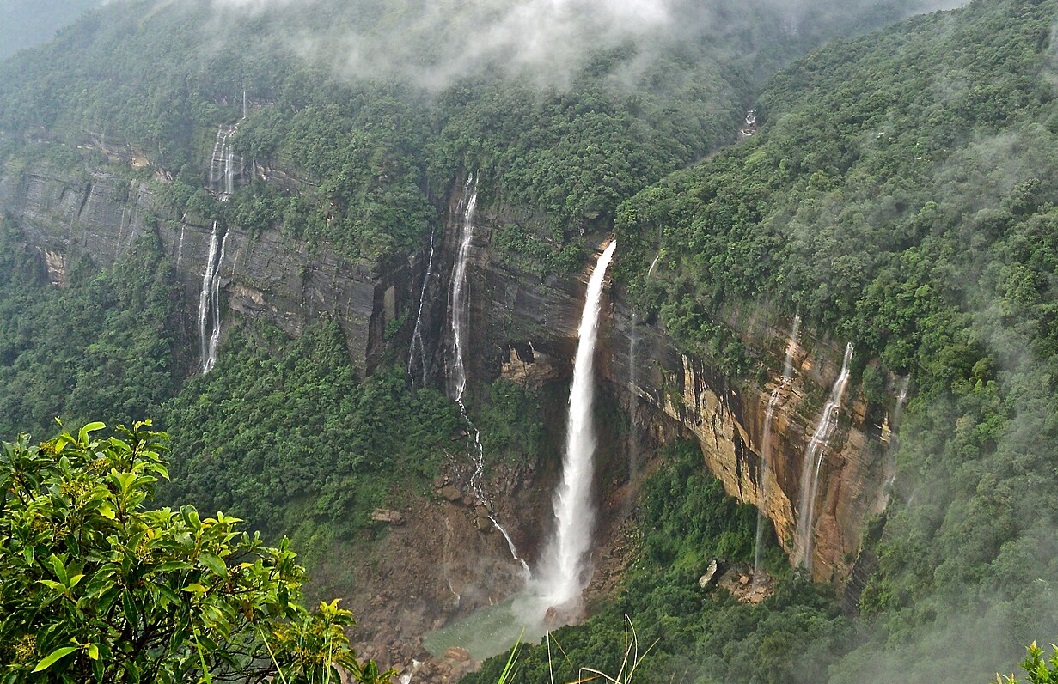Meghalaya: The Abode of Clouds, Where Nature Reigns Supreme
Tucked away in Northeast India’s lush embrace, Meghalaya is a tapestry of undulating hills, gushing waterfalls, and ancient living root bridges. Being the wettest area on Earth, this beautiful tiny state, also known as the “Abode of Clouds,” has the highest average annual rainfall, with Cherrapunjee receiving the most. Meghalaya is alive with a rich tribal culture, a profound respect for the natural world, and an intriguing past that begs to be discovered.

A Glimpse into the Past: From Megalithic Monuments to Enduring Spirit
The history of Meghalaya dates back many centuries. There is evidence that people inhabited the area as early as 2000 BC. The majority ethnic group, the Khasi, are thought to have immigrated from Southeast Asia centuries ago. They adopted a matrilineal system of inheritance and created a sophisticated social structure based on communities. Massive stone constructions known as megalithic monuments, such as menhirs and dolmens, are evidence of their superior architectural skills and rich cultural legacy.

A turning point occurred with the arrival of the British in the 19th century. The fiercely independent Khasi tribes resisted the British attempts to impose colonial rule in the area. Christianity, which is currently the most popular religion in Meghalaya, was brought there by British influence. In 1972, Meghalaya became a state, ushering in a new era in its history. Since then, the state has prioritized economic growth over maintaining its own culture and customs. In Northeast India today, Meghalaya is a shining example of both environmental awareness and cultural legacy.
A Tapestry of Tribes: A Celebration of Diversity
Meghalaya is home to a diverse range of tribal communities, each with its own language, traditions, and customs. The Khasi people are well-known for their elaborate beading and excellent workmanship, and they are also noted for their matrilineal society. The Garo people, who live in the western hills, are well-known for their colorful dances like the Wangala and their extensive culture. The language and festivals of the Jaintia people, who are found in the eastern region of the state, are distinctive manifestations of their cultural heritage.

The Khasi community hosts the yearly Nongkrem Dance Festival, which is a colorful celebration of their culture. A captivating display is produced as villagers show off their dance prowess while dressed in vibrant costumes. The Jaintia people commemorate the harvest season and pay tribute to their ancestors during the Shad Suk Mynsiem festival. These celebrations provide a glimpse into the diverse range of customs that are intricately woven throughout Meghalaya.
Living Bridges: A Testament to Ingenuity and Harmony with Nature
Meghalaya’s network of living root bridges is one of its most striking features. These clever constructions have been utilized for generations to cross the numerous rivers and streams in the state.

They were made by the Khasi people utilizing the aerial roots of Ficus elastica trees. Decades are needed to complete the intricate weaving of the roots, which is a monument to the Khasis’ extraordinary architectural prowess and profound regard for the natural world.
A Feast for the Senses: Culinary Delights and Artistic Expressions
The different influences of the state are reflected in the rich cuisine of Meghalaya. The main food is rice, which is frequently served with stews and curries made with vegetables and meats such dried fish and hog that are purchased locally. A popular meal among the locals, “Doh Khlieh,” is fermented pork with a unique aroma. ‘Jadoh,’ a spicy rice meal prepared with red chilies and spices, is a good choice for vegetarians.

Meghalaya has a strong artistic heritage in addition to its cuisine. Weavers of delicate baskets for carrying and storing possess a skill that is highly valued. Another kind of art is wood carving, which is used to ornament furniture and other home goods with images of gods and animals. Some towns have a thriving blacksmithing industry, as seen by the production of age-old tools and weapons.
A Haven for Nature Lovers: Unveiling Untamed Beauty
For those who love the outdoors, Meghalaya’s lush hills, gushing waterfalls, and tranquil lakes provide a sanctuary. Hiking paths meander through verdant forests, providing access to breath-taking vantage points and obscure waterfalls such as the remarkable Nohkalikai Falls, which is among India’s tallest waterfalls. Enthusiasts of caving can go into the many caverns dotting the state, some of which are embellished with naturally occurring stalactites and stalagmites.

A multitude of national parks and wildlife sanctuaries are also located inside the state. The highest peak in Meghalaya, Shillong Peak, offers expansive views of the surrounding countryside. Nokrek National Park offers opportunities to spot diverse flora and fauna, including rare species like the clouded leopard and the Asian elephant.
A Spiritual Tapestry: A Land Steeped in Tradition
Meghalaya’s varied cultural fabric skillfully combines spirituality. Animism, which is part of the Khasi culture, is a belief in nature spirits that coexists with Christianity. Sacred groves, which act as gods’ sanctuaries, represent this respect. The monotheistic foundations of Jaintia, which honor U Blei, are mingled with Christianity and Hinduism today. The celebrations of the Garo people are enhanced by their ancestor worship and mythology. Religious variety is reflected in pilgrimage destinations like the scenic town of Mawlynnong and the Nartiang Durga Temple. The Cathedral of Mary Help of Christians, one of Shillong’s architectural wonders, embodies spiritual legacy.

A Look Ahead: Balancing Progress and Preservation
Meghalaya’s development journey is not without difficulties. It takes constant work to strike a balance between the state’s distinct cultural legacy and pristine environment and the necessity for economic progress. Sustainable methods are required due to environmental issues, including those related to soil erosion and deforestation. Opportunities for economic growth are provided by promoting ecotourism and traditional crafts without sacrificing the state’s natural beauty.
